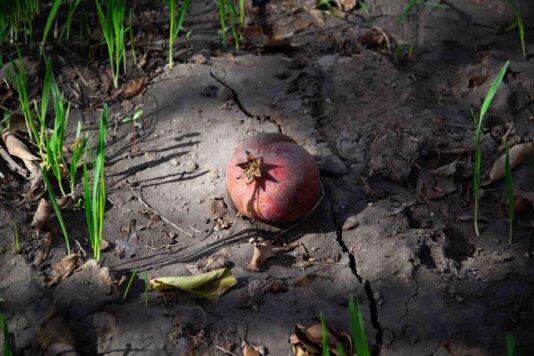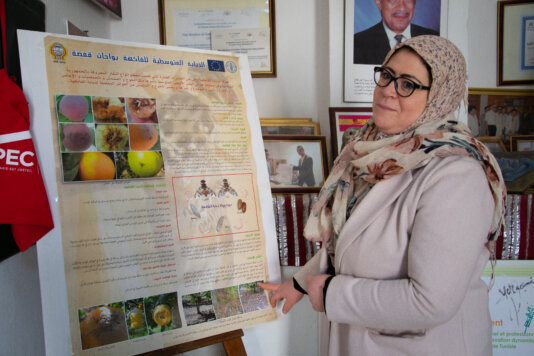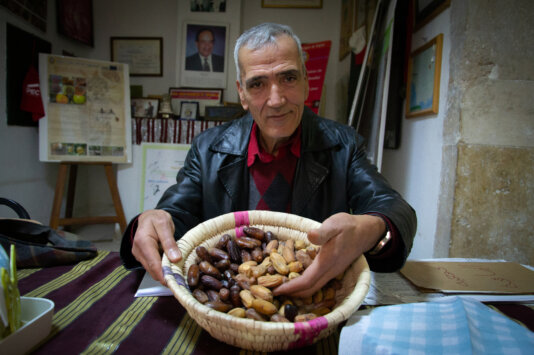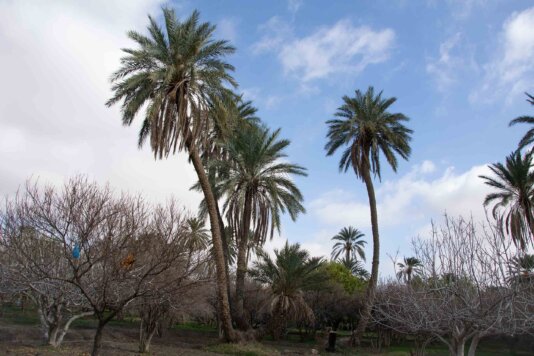- About
- Topics
- Story
- In-Depth
- Picks
- Opinion
- News
- Donate
- Signup for our newsletterOur Editors' Best Picks.Send
Read, Debate: Engage.
| August 29, 2024 | |
|---|---|
| tags: | #Tunisia, #climate change, #drought, #Sustainable Agriculture, #monoculture |
| located: | Tunisia |
| by: | Nadia Addezio |
Five hours from Tunis, the sun sets over the southwestern city of Gafsa. Walking through Medina’s calm, narrow, labyrinthine alleys, the muezzin's call to prayer overlaps with Google Maps, which guides the way past the Roman bath before arriving at Dar Longo. Gafsa’s Medina is built around water sources. "All of its paths lead to the water that irrigates the Historic Oasis," explained Hatem Zitouni, 62.
With a tired glance and an animated voice, he entered one of the apartments where the city's Wali once resided. Today, this space houses the Association for the Safeguarding of Gafsa’s Medina (ASM Gafsa), a non-profit organisation dedicated to conserving the town centre's natural and cultural heritage, which Mr Zitouni presides over.
Over the years, the development of Gafsa’s governorate and its capital city has been closely linked to the emergence of its oases. These oases formed when the groundwater sources of Gafsa-nord surged to the surface. This hydric surprise attracted the Romans, who arrived in then-Numidian "Capsa" in the 2nd century B.C. and constructed the famous Roman baths over the Tarmil, el Kasbah and Métouia springs. Today, Gafsa’s oases cover 3,000 hectares, accounting for 5 per cent of Tunisia’s total oasis area of 54,000 hectares.
Local people adapted to the naturally arid territory and its limited resources by developing and passing down traditional agricultural good practices to effectively manage soil and water.
Zitouni, a native of Gafsa and a university lecturer specialising in English literature and civilisation at the University of Gafsa, emphasised, "We have to listen to these people, caretakers of an agrarian know-how whose efficiency has been proven." Zitouni became president of ASM Gafsa in 2016, having always been an active volunteer for the association. He is also an oasis farmer, like many of his family members.
Generally, most of the farmers in the Gafsa Oasis are members of ASM Gafsa, reflecting their commitment to its preservation. "If we encouraged them, we could combat climate change," Zitouni said.
Climate change is one of the challenges threatening this natural hydraulic system. Intensive agriculture, industrial exploitation - particularly for Compagnie des Phosphates de Gafsa’s phosphate washing activities - urban expansion, and excessive soil drilling are also major concerns. According to the World Bank, groundwater exploitation in Gafsa’s governorate reached 157 percent in 2015.
In 2023, the Commissariat Régional au Développement Agricole (CRDA) estimated there were 32,320 drillings in Gafsa, with 19,000 of them being illegal - almost half of the total.
ASM Gafsa is actively working to protect the surrounding ecosystem, with particular focus on the "Historic Oasis of Gafsa," also known as the "Oasis of Kasbah."
As part of the governorate’s oases, the Historic Oasis stretches along the town centre and covers 700 hectares. It is recognised by the Food and Agriculture Organisation of the United Nations (FAO) as an "Ingenious System of World Agricultural Heritage" (SIPAM) due to the unique and traditional practices adopted by its farmers.
Like all oases, it features a multi-layered agrisystem, consisting of fodder and horticultural crops at the first level, fruit trees at the intermediate level and date palms at the highest level. Walking among the pomegranate and lemon trees, feeling the ground's dampness while Zitouni explained the mineral-rich soil composition, it was astonishing to witness the harmonious biodiversity that thrives there.
Yet, attention was drawn to the bare trees and dried palm leaves. It was evident that groundwater depletion is worsening the drought affecting all of Tunisia.
"If this agricultural system were destroyed, the entire population would be unemployed. What would they do? They would certainly emigrate. We must provide water to these people," Zitouni said, voicing his concerns for the future of the 2,500 permanent rural workers and 5,000 seasonal labourers, especially women, who depend on the oasis for their livelihoods.
But the Kasbah Oasis is also experiencing degradation due to soil overexploitation, driven by the monoculture of Deglet Nour, a date variety originating from Algeria known as "the queen of dates," which is highly prized abroad.
"We try to urge the State not to focus on the production of Deglet Nour because it uses large quantities of water compared to Tunisia’s water situation," said Rihab Mabrouki, coordinator of the Environmental Justice section at the Tunisian Forum of Economic and Social Rights (FTDES), an independent non-governmental organisation at the forefront of advocating for water rights.
Quiet and determined, Mabrouki, in a conversation with FairPlanet, described her work with FTDES, stating, "Deglet Nour variety is not intended for local people, but for export. This means that exports and investments are prioritised instead of citizen’s right to drinkable water."
The Deglet Nour variety consumes around 20,000 cubic metres of water per hectare. The National Agriculture Observatory (Onagri) estimates that 114,700 tonnes of dates were exported between September 2023 and April 2024. Last October, Deglet Nour accounted for 80.1 per cent of dates exported, and between 2022 and 2023, out of 22,900 tonnes of dates exported, the largest recipients were Morocco (17.7 per cent), Italy (7.8 per cent), and France (7.6 per cent). Overall, exports to Europe accounted for 48.7 per cent.
"It’s elementary: encouraging Deglet Nour production means killing the biodiversity and genetic resources of the Oases," Zitouni said.
Since the 1970s, 'modern oases' have begun to emerge in Tunisia. This shift coincided with the country’s transition to a liberal economy and followed the rehabilitation and renewal programmes for "traditional oases" implemented through the General Plan of South Water (PDES). Unlike the 'traditional oases,' which focused on 'producing to eat and survive,' modern oases have been geared towards trade. They have expanded due to the generous approvals given over the years by state authorities to agricultural companies for deep drilling ("fracking"), driven by soaring foreign demand and the reduction of surface water.
Currently, Tunisia is developing a new Water Code - updating the 1975 version - to specifically address the challenges of hydric stress and illegal drilling.
"Tunisian people do not consume Deglet Nour. In Gafsa, we eat Kentichi, which requires a limited amount of water, and Ftemi - also known as 'Aligh' - because it lasts for a long time," Zitouni stated.
In Gafsa’s governorate, 5 per cent of cultivated date palms are Deglet Nour. In the Historic Oasis, there are 18 date varieties, with the majority represented by Ftemi (706 palms), Deglet Nour (308 palms) and Besr Helou (133 palms). There are only 4 Kentichi palms, which are known to withstand parasites like Oligonychus afrasiaticus, the "dust mite" that affects date palms and thrives in high temperatures and water shortages.
"We cannot produce Deglet Nour without also growing its 'wind-breaker' Kentichi. If a tree is missing, it would disrupt this balanced ecosystem," Zitouni explained, highlighting ASM Gafsa’s lobbying efforts against Deglet Nour monocultures and in favour of ecosystem restoration and management.
Ultimately, "the queen of dates" appears to be more vulnerable to attacks by the dust mite and Ectomyelois ceratoniae ("carob moth"), which can damage over 20 per cent of its harvest.
Moreover, the frequent parasite attacks are compelling farmers to use massive amounts of pesticides, which can lead to the dangerous vicious cycle of resistance to active ingredients.
According to Samah Ben Chaabane, an entomologist and acarologist at the Centre Régional de Recherche en Agriculture Oasienne, "We have to clean the oases to disrupt the parasites' reproductive cycle." As a preventive measure, she added, "We use organic sulfur to repel insects. In case of an epidemic, farmers will be alerted via SMS by state authorities to stay vigilant."
Ben Chaabane's dedicated commitment to ASM Gafsa and FTDES in raising farmers' awareness is grounded in concrete actions. However, all these efforts to save the Historic Oasis of Gafsa hinge on Tunisia recognising the oases as "vulnerable ecosystems" rather than merely viewing them as "irrigation areas," Zitouni emphasised.
He warned, "I tell you what Tunisia would be without oases: the desert would reach Carthage!"
Image by Nadia Addezio.
By copying the embed code below, you agree to adhere to our republishing guidelines.



